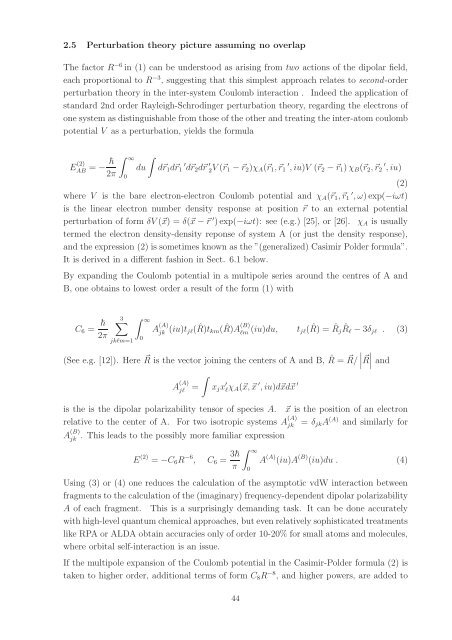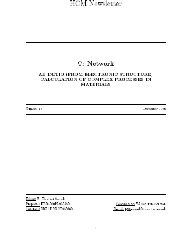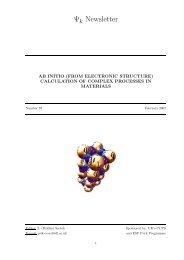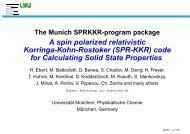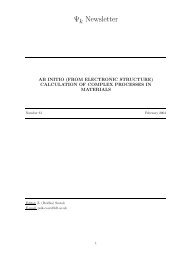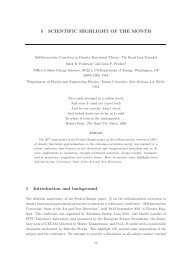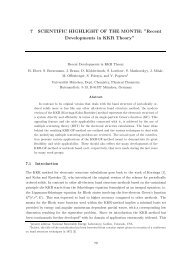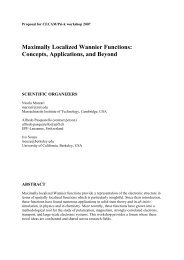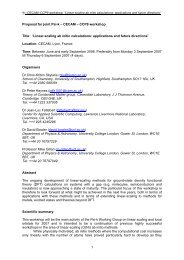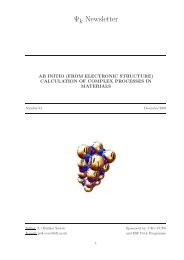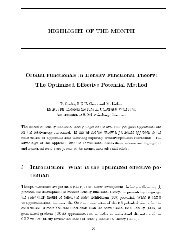Newsletter 107 - October 2011 - (pdf - 0.6 MB) - Psi-k
Newsletter 107 - October 2011 - (pdf - 0.6 MB) - Psi-k
Newsletter 107 - October 2011 - (pdf - 0.6 MB) - Psi-k
You also want an ePaper? Increase the reach of your titles
YUMPU automatically turns print PDFs into web optimized ePapers that Google loves.
2.5 Perturbation theory picture assuming no overlap<br />
The factor R −6 in (1) can be understood as arising from two actions of the dipolar field,<br />
each proportional to R −3 , suggesting that this simplest approach relates to second-order<br />
perturbation theory in the inter-system Coulomb interaction . Indeed the application of<br />
standard 2nd order Rayleigh-Schrodinger perturbation theory, regarding the electrons of<br />
one system as distinguishable from those of the other and treating the inter-atom coulomb<br />
potential V as a perturbation, yields the formula<br />
E (2)<br />
AB = − <br />
2π<br />
∫ ∞<br />
0<br />
∫<br />
du<br />
d⃗r 1 d⃗r 1 ′ d⃗r 2 d⃗r ′ 2V (⃗r 1 − ⃗r 2 )χ A (⃗r 1 ,⃗r 1 ′ , iu)V (⃗r 2 − ⃗r 1 ) χ B (⃗r 2 ,⃗r 2 ′ , iu)<br />
(2)<br />
where V is the bare electron-electron Coulomb potential and χ A (⃗r 1 ,⃗r 1 ′ , ω) exp(−iωt)<br />
is the linear electron number density response at position ⃗r to an external potential<br />
perturbation of form δV (⃗x) = δ(⃗x − ⃗r ′ ) exp(−iωt): see (e.g.) [25], or [26]. χ A is usually<br />
termed the electron density-density reponse of system A (or just the density response),<br />
and the expression (2) is sometimes known as the ”(generalized) Casimir Polder formula”.<br />
It is derived in a different fashion in Sect. 6.1 below.<br />
By expanding the Coulomb potential in a multipole series around the centres of A and<br />
B, one obtains to lowest order a result of the form (1) with<br />
C 6 = <br />
2π<br />
3∑<br />
jklm=1<br />
∫ ∞<br />
0<br />
A (A)<br />
jk (iu)t jl( ˆR)t (B)<br />
km ( ˆR)A<br />
lm (iu)du, t jl( ˆR) = ˆR j ˆRl − 3δ jl . (3)<br />
(See e.g. [12]). Here R ⃗ is the vector joining the centers of A and B, ˆR = R/ ⃗ ∣R<br />
⃗ ∣ and<br />
∫<br />
A (A)<br />
jl<br />
=<br />
x j x ′ lχ A (⃗x,⃗x ′ , iu)d⃗xd⃗x ′<br />
is the is the dipolar polarizability tensor of species A. ⃗x is the position of an electron<br />
relative to the center of A. For two isotropic systems A (A)<br />
jk<br />
= δ jk A (A) and similarly for<br />
. This leads to the possibly more familiar expression<br />
A (B)<br />
jk<br />
E (2) = −C 6 R −6 ,<br />
C 6 = 3 π<br />
∫ ∞<br />
0<br />
A (A) (iu)A (B) (iu)du . (4)<br />
Using (3) or (4) one reduces the calculation of the asymptotic vdW interaction between<br />
fragments to the calculation of the (imaginary) frequency-dependent dipolar polarizability<br />
A of each fragment. This is a surprisingly demanding task. It can be done accurately<br />
with high-level quantum chemical approaches, but even relatively sophisticated treatments<br />
like RPA or ALDA obtain accuracies only of order 10-20% for small atoms and molecules,<br />
where orbital self-interaction is an issue.<br />
If the multipole expansion of the Coulomb potential in the Casimir-Polder formula (2) is<br />
taken to higher order, additional terms of form C 8 R −8 , and higher powers, are added to<br />
44


